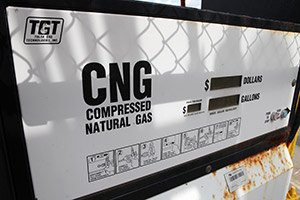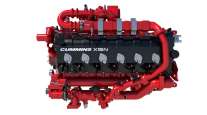In New York, Natural Gas Growing Slowly as Alternative Fuel for Trucks

Running a truck with natural gas instead of diesel cuts down on cost, noise and exhaust emissions. But those benefits come with a big caveat: There are only a few dozen places in New York state that the public can fuel up with natural gas.
There’s one more now, as Saratoga Springs-based American National Gas has a new station up and running on the home city’s west side. That brings its network to 16 stations in New York, Vermont, Indiana, Kentucky and Arkansas, and the company is planning to open No. 17 soon in Syracuse.
RELATED: UPS drives 1 billion miles using alternative fuels
CEO Andrew West said American National Gas is bullish on natural gas for a few reasons. The technology to run commercial trucks with compressed natural gas has existed for decades, he said, but a combination of low, stable natural-gas prices and improved technology recently has made gas engines attractive and a network of CNG stations a safer investment.
“Those are the things that help you get to critical mass,” he said.
West singled out the Cummins-Westport 12-liter natural-gas engine — manufactured in western New York — as a turning point when it came on the market a few years ago, because it’s a powerful unit that could be put right into service without all the modifications that need to be made to diesel engines before they can burn natural gas.
Previously, West said, “You couldn’t get a test vehicle; you couldn’t get managed leases.”
He added: “Then there was the infrastructure problem — it’s the chicken and egg. There’s a lot of technology that goes into our stations. These pieces of the puzzle had not been readily available.”
RELATED: Opinion - CNG - A highly efficient domestic fuel
A natural-gas refueling station can work with just about any gas main, West said. He prefers to draw from higher-pressure lines. But if the only source is the common gas main one might find on a residential street, gas from it can be recompressed on site. Stations also have dryers to remove moisture from the gas.
A small amount of dried, compressed gas goes into a buffer zone while a truck is being refueled, but there’s not a gas tank on-site, holding processed gas ready for the next truck.
Jennifer Ceponis of Capital District Clean Cities — a public-private coalition charged by the U.S. Department of Energy with reducing petroleum consumption in the Capital Region — said alternative-fuel vehicles are an important part of the effort.
“We have an increasing demand for and use of CNG vehicles and, really, all alternative-fuel vehicles,” she said.
In this area, she said, one of the largest operators of alternative-fuel vehicles is National Grid. Others include Verizon, Albany International Airport, Capital District Transportation Authority and the state of New York, which has a fleet of nearly 500 statewide.
“We displace about 2 million gallons of petroleum in the Capital District annually,” Ceponis said, referring to conservation efforts. That equates to 16,000 tons of greenhouse gases not generated in 2015, she added.
Upstate New York grocery chain Tops Friendly Markets switched to CNG in 2015. West, at American Natural Gas, said Tops did a trial run with one CNG tractor and decided to swap out its entire fleet. American Natural Gas developed a CNG fueling facility at Tops’ distribution center in suburban Buffalo, and the changeover started about a year ago — Sept. 2, 2015.
“Through a partnership with Ryder, American Natural Gas and with the assistance of National Fuel, Tops replaced its existing 55 tractors with ones that are compatible with compressed natural gas,” Kevin Darrington, executive vice president of supply chain, said via e-mail.
At the other end of the consumer process is Casella Waste Systems, which operates a fleet of 800 trash collection trucks in New York, New England and Pennsylvania, including Saratoga County, where it uses the new American Natural Gas CNG station.
Peter Vanderhoof, fleet and facilities energy director for Casella, said the company has only 30 CNG trucks because of limited availability of refill stations but expands the fleet wherever it can.
“We’re always looking to, where it makes sense,” he said. “It fits our sustainability profile.”
There’s a competitive incentive, sometimes — municipalities may put an alternative-fuel requirement in their contracts, and CNG trucks help Casella meet that mandate.
But there’s also a financial incentive: “Natural gas is more cost-effective,” Vanderhoof said, and “it’s about 30% cleaner than diesel fuel.”
The downside of a CNG truck is its cost, about $30,000 to $40,000 more than a diesel-powered garbage truck, he said. When diesel prices soar, the CNG truck pays for itself very quickly. When diesel prices plummet — they’re at a several-year low currently — it can take quite a while to recoup the investment in a CNG truck.
Vanderhoof recalled that there was a learning curve for Casella’s drivers and managers with the first CNG garbage trucks.
“As an early adopter, we had our fair share of ups and downs with the CNG engines because we were in front of the line,” he said.
Chief among them was the drivers worrying about running out of gas away from the fueling station.
“We call it range anxiety,” he said. “We didn’t anticipate the length of the routes in some locations. We did wind up having to put extra tanks on some of the trucks.”
That’s a limited option, because there’s so little available space on a garbage truck.
As the CNG landscape improves, however, running out of gas is less of a concern within a specific service region, Vanderhoof said.
“It gets better and better. There’s lots of stations now.”




